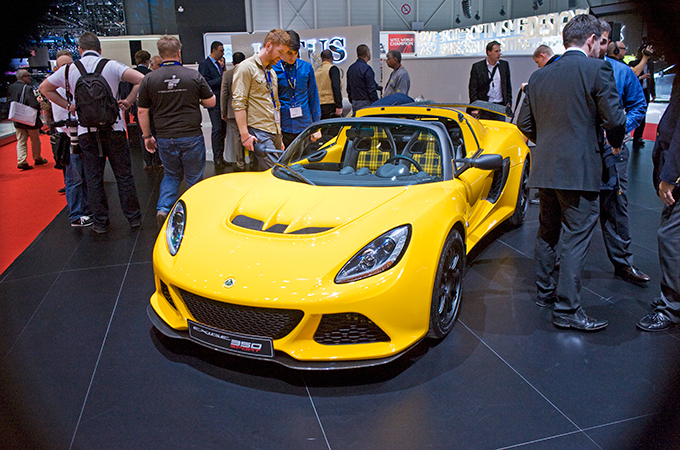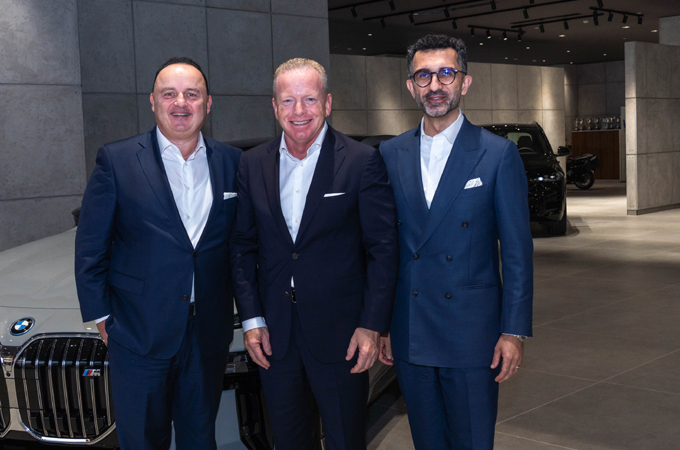Mon, Mar 14, 2016
A new line-up of faster and lighter road cars from Lotus built on the UK manufacturer’s “light is right” approach to engineering have gone on sale.
The four new cars were launched at the 2016 Geneva International Motor Show.
With all four models capable of 0-60 mph (0-97 kmph) in 3.9 seconds or less, the 2016 range drives home the UK company’s commitment to developing pure, driver-focused sports cars with exceptional performance.
Covering the entire Lotus portfolio, the four cars displayed included the debut of the Exige Sport 350 Roadster as well as the recently announced Evora Sport 410 and Elise Cup 250. The spectacular Lotus 3-Eleven was also on show, following its success on the notorious Nürburgring Nordschleife.
Each of the four cars has been developed through Lotus’ Lightweight Laboratory concept. Thoroughly re-evaluated, the cars represent the epitome of Lotus’s “light is right” approach to engineering.
Lotus CEO Jean-Marc Gales said: “We set the benchmark for added lightness - this is what Lotus does and nobody does it better. We are making our best ever cars, and across the world more customers are experiencing what a Lotus is capable of.”
EVORA SPORT 410
The new top-of-the-range Evora has a 70 kg drop in kerb weight and a power boost, thanks to the supercharged engine it shares with the track-bred Lotus 3-Eleven. With a host of high-performance carbon fibre components as standard, the car clocks 0-60 in 3.9 seconds on its way to a top speed of 186 mph (300 kmph).
With a lower centre of gravity, and a kerb weight slashed to just 1,325 kg, the car provides an impressive 309 hp/tonne, and builds on the achievements of the Evora 400.
In addition to boosting acceleration, the significant reduction in mass has allowed the recalibration of the suspension, with revised geometry and damping, to deliver sharper, more agile and intuitive handling. However, far from a stripped-out special, the Evora Sport 410 retains excellent road manners proving refined and composed during every-day driving.
LOTUS EXIGE SPORT 350 ROADSTER
The new Exige Sport 350 Roadster made its world debut at the show. Hot on the heels of the coupe version, this Roadster derivative of the iconic sports car is lighter and faster than ever before, thanks to a 40 kg weight drop, compared to the hardtop version.
By selecting the lightweight options available, including a Lithium-ion battery, lightweight forged alloy wheels, cross drilled and vented two-piece brake discs, together with carbon fibre items such as the rear tailgate, side air intakes and seats as well as a revised composite front access panel the total weight of the car can be reduced to 1,085 kg – the lightest possible incarnation of the current generation Exige.
A carbon aero pack includes a front splitter, rear wing and rear diffuser made from carbon fibre.
As the lightest ever V6 powered Exige, the 345 hp roadster boasts a 0-60 mph time of 3.7 seconds, and a top speed of 150 mph (241 kmph).
The Roadster also features the heavily revised manual gearbox from the coupe, to provide faster and more precise gear selection. As standard, lightweight components include a louvered tailgate panel, a lighter battery and lightweight engine mounts.
A 6-speed automatic gearbox is available as an option, with electronically optimised up-shifts. Drivers can change gears manually via forged aluminium paddles mounted to the steering wheel, or rely on the gearbox’s fully automatic mode.
Optional trim packs provide a heritage theme to the cabin with lightweight sports seats and door panels clad in red or yellow Tartan, with leather or Alcantara interior trim options also available.
LOTUS ELISE CUP 250
Having shed 21 kg and gained 26 hp, the new Elise Cup 250 can accelerate from 0-60 mph in 3.9 seconds and deliver a top speed of 154 mph (248 kmph).
Powered by a new higher-output version of the supercharged, 1.8-litre 4-cylinder engine, the car boasts 243 hp. Long seen as the benchmark for handling, the Lotus Elise Cup 250 is available for the first time as a roadster as standard with a hard top available as an option.
An optional carbon aero pack can replace the standard front splitter, rear wing, rear diffuser and side floor-extensions with lightweight carbon components. Suitable for those wanting to boost performance, the pack cuts the car’s weight by an extra 10 kg, reducing the mass to just 921 kg.
LOTUS 3-ELEVEN
The 3-Eleven is the Lotus’s quickest and most expensive series production car ever. It has a new lightweight composite body and a chassis based on the Lotus design of extruded and bonded aluminium sections.
The 3-Eleven offers a giant-slaying power-to-weight ratio, thanks to a revised V6 supercharged engine developing 460 hp to provide in excess of 500 hp per tonne. It is capable of sprinting from 0-60 mph in 2.9 seconds before reaching a maximum speed of 180 mph (290 kmph).
The Lotus 3-Eleven spent time at the Nürburgring Nordschleife, where it was one of the fastest road-going cars to ever tackle the track, capable of setting a sub-7 minute lap time.
The 3-Eleven is available in road and track versions, at prices staring from £82,500 ($119,000) and £116,500 ($167,000) respectively.
All of the four models are available for order.
A subsidiary of DRB-HICOM, Group Lotus is based in the UK and has three operating divisions: Lotus Cars, Lotus Engineering and Lotus Motorsport.
The Geneva International Motor Show ended in Geneva, Switzerland, yesterday.





















